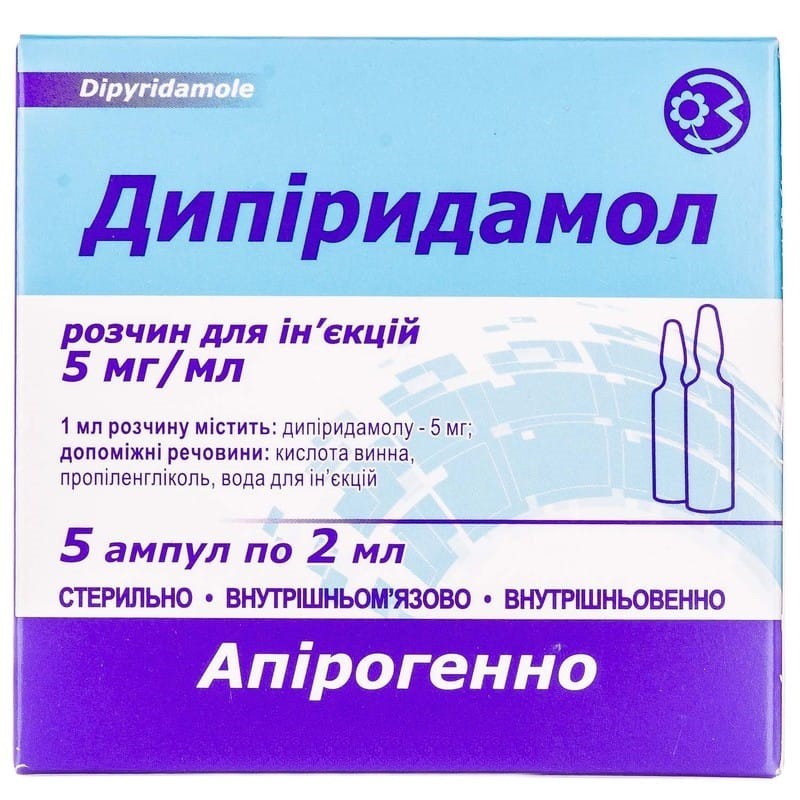



 Secure and encrypted payment processing
Secure and encrypted payment processing We ship to over 40 countries including the USA, UK, Europe, Australia and Japan
We ship to over 40 countries including the USA, UK, Europe, Australia and Japan Guaranteed refund or reship if you haven't received your order
Guaranteed refund or reship if you haven't received your order
Tradename
Dipyridamole Dipyridamolum
International name
dipyridamole
Latin name
Dipipridamolum
general characteristics
basic physical and chemical properties: transparent yellow liquid; composition: 1 ml of the solution contains dipyridamole - 0.005 g; excipients: tartaric acid, propylene glycol, water for injection.
Release form
Injection
Farmgroup
Antithrombotic agents. Antiplatelet agents. PBX code B01A C07.
Pharmacological properties
Dipyridamole dilates the coronary vessels, increases the volumetric rate of coronary blood flow, improves the supply of myocardium with oxygen, and increases its resistance to hypoxia. Helps to improve blood circulation in the collateral vasculature in case of violations in the main coronary vessels. Reduces total peripheral vascular resistance, slightly lowers systemic blood pressure, improves cerebral circulation. Dipyridamole is a competitive inhibitor of adenosine deaminase - an enzyme that breaks down adenosine, which helps to increase the formation of adenosine, which is involved in the autoregulation of coronary blood flow. The drug inhibits platelet aggregation and prevents thrombosis. This effect is probably due to stimulation of prostacyclin synthesis and inhibition of thromboxane biosynthesis. With an increase in the production of prostacyclin in the vascular wall, the effect of the drug on the metabolism of arachidonic acid is associated. The antiplatelet activity of dipyridamole is close to such acetylsalicylic acid.
Pharmacokinetics
The bioavailability of the drug is 37-66%. The time to reach the maximum concentration in the blood is 40-60 minutes. Communication with plasma proteins - 80-95%. Penetrates quickly into tissues. It is metabolized in the liver with the formation of monoglucuronide, which is excreted in the bile.
Indications for use
Dipyridamole is prescribed as an antiplatelet agent for the prevention of postoperative thrombosis, with myocardial infarction, cerebrovascular accident, limitedly as a coronarolytic agent for chronic coronary heart disease.
Dosage and administration
Adults and children over 12 years of age - intramuscularly or slowly intravenously injected with 1-2 ml of a 0.5% solution per day.
Side effects
Short-term hyperemia of the facial skin, tachycardia, headache, allergic skin rash.
Contraindications
Common coronary atherosclerosis, acute myocardial infarction, decompensated heart failure, arrhythmias, hypotension, renal failure, pregnancy, children under 12 years old. You can not enter intravenously in the pre-collapse state and collapse.
Interaction with other drugs
The solution of the drug should not be mixed in the same syringe with other drugs. With simultaneous use with oral anticoagulants and acetylsalicylic acid, as well as with penicillin antibiotics, cephalosporins, tetracycline, chloramphenicol, the antiplatelet effect of Dipyridamole is enhanced. Dipyridamole is incompatible with xanthine derivatives.
Overdose
An overdose of the drug leads to short-term hypotension. When signs of an overdose appear, the introduction of vasopressor agents is necessary.
Application features
With parenteral administration, the drug should not be allowed to enter the skin (possibly an irritative effect). Violations of the functions of the liver and biliary tract necessitate a reduction in dose.
Terms and conditions of storage
Keep out of the reach of children, protected from light. Shelf life is 3 years.
Holiday Terms
On prescription.
Packaging
2 ml in ampoules, 5 ampoules in a pack
Manufacturer and his address
DP "Experimental Plant GNTsLS" State Joint-Stock Company "Ukrmedprom" Ukraine, Kharkov, st. Vorobyev, 8.